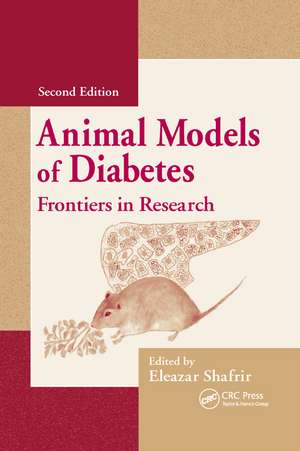Animal Models of Diabetes: Frontiers in Research
Editat de Eleazar Shafriren Limba Engleză Paperback – 18 oct 2019
Including contributions from prominent experts in the field, the book brings together scattered data and lucidly presents it. This promotes the understanding of the etiopathology of diabetes and offers a new grasp of the insulin action, its negative feedback leading to insulin resistance, and its detrimental outcomes. The book also includes new knowledge on specific complications of diabetes, offering an incentive to test advanced modalities to prevent and inhibit their occurrence.
Preț: 368.57 lei
Preț vechi: 483.82 lei
-24% Nou
Puncte Express: 553
Preț estimativ în valută:
70.54€ • 73.37$ • 58.23£
70.54€ • 73.37$ • 58.23£
Carte tipărită la comandă
Livrare economică 14-28 aprilie
Preluare comenzi: 021 569.72.76
Specificații
ISBN-13: 9780367389253
ISBN-10: 0367389258
Pagini: 384
Dimensiuni: 156 x 234 mm
Greutate: 0.36 kg
Ediția:2
Editura: CRC Press
Colecția CRC Press
ISBN-10: 0367389258
Pagini: 384
Dimensiuni: 156 x 234 mm
Greutate: 0.36 kg
Ediția:2
Editura: CRC Press
Colecția CRC Press
Public țintă
Professional Practice & DevelopmentCuprins
Autoimmune diabetes, present status of knowledge in animals and the implications for the understanding and preventing of human type 1 diabetes. Diabesity in ob/ob and db/db mice: the use of these models for studies of diabetes and obesity in humans. The Zucker diabetic fatty rat: lessons from leptin receptor deficiency. The Goto-Kaizaki diabetic rat evolved by selective inbreeding. Then NSY mouse, an animal model with human type 2 diabetes with polygenic inheritance. The new Zealand obese mouse, a polygenic model of type 2 diabetes, metabolic abnormalities without single genetic mutation. The OLETF rat, spontaneous interaction of diabetes and obesity and the associated nephropathy. The JCR: Lacp rat a model of obesity, insulin resistance, and atherosclerosis cardiovascular disease. The neonatally sterptozotocin induced diabetic rat: a family of type 2 diabetes like animal models. The rhesus monkey (Macaca Mulatta) a model for the study of gradual development of diabetes on ad libitum nutrition. The desert gerbil, Psammomys obesus: molecular mechanisms of the nutritionally induced diabetes, and its prevention; validity for study of factors underlying the prevalent diabetes epidemic, related to affluent nutrition. The C57BL6J mouse, a model of diet induced type 2 diabetes, hypertension, and obesity. The obese, spontaneously hypertensive SHROB, Koletzky rat: a model for human metabolic syndrome. The diabetic minipig, sharing physiologic and digestion characteristics with the human. The spontaneously diabetic Torii (SDT) rat with human resembling retinopathy lesions.
Descriere
This new edition of Animal Models of Diabetes provides researchers with updated and expanded information regarding the use models in experiments with both Type 1 and Type 2 diabetes. It compiles relevant timesaving information on most, if not all, current well-recognized models for both types of diabetes, including various mice, rats, minipigs and Rhesus monkeys, and provides extensive references for more in-depth study. Among several other topics, it discusses nutritionally diabetes-prone animals, and considerations of insulin resistance and obesity. It also addresses the importance of recent findings on pathogenesis of diabetes and its complications in relation to human disease.
